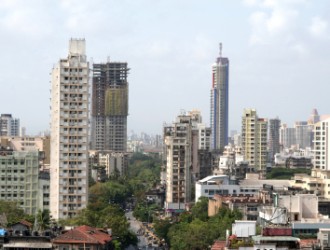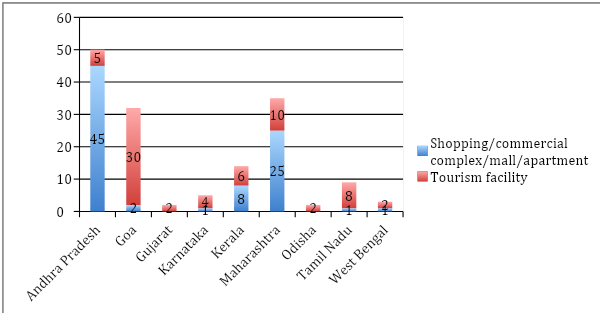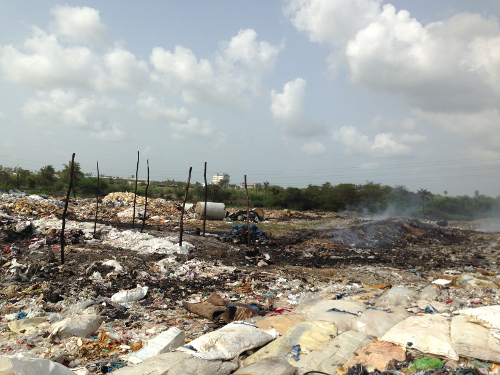In June this year, the Ministry of Environment, Forests and Climate Change (MoEFCC) issued an amendment to the Coastal Regulation Zone (CRZ) Notification of India. The notification was first issued in 1991, restricting development on the coast till 500 metres of the high tide line of the sea. After going through a series of amendments the notification was replaced by a new one in 2011.
The new notification divided the entire coastal regulation zone into four: CRZ I (ecologically sensitive), CRZ II (urban), CRZ III (rural) and CRZ IV (water) areas. The recent amendment relaxes building norms, except Floor Area Ration (FAR)/ Floor Space Index (FSI) in CRZ II (urban) areas of the country.

Mumbai's skyline. Pic: India Together File photos
Prior to this amendment, building regulations were fixed for CRZ II areas, except in Goa, Kerala and Mumbai, at the levels of 1991. It means that while the concerned town and country planning departments could update the norms for building height, number of floors, etc. in areas under their jurisdiction, they could not do so for the cities and towns falling in the CRZ.
With the current amendment, the coasts have been opened up to high-rise buildings, which will provide more space for hotels, malls, office complexes and apartments. Real estate developers and hoteliers have lauded the amendment. Since the FSI has not been relaxed, only vertical extensions are possible, which they view as the perfect solution to balance out the housing needs of the coastal population and coastal conservation.
However, a closer look at the areas that already have building relaxations in place and a follow up on certain stipulations of the CRZ Notification should have preceded this amendment to make it a perfect solution in actual.
Problems of coastal cities
The chart below gives the number of projects concerning tourism, commercial complexes and apartments that have been approved by the nine State Coastal Zone Management Authorities (SCZMAs), from January 2011 to March 2014.

Source: Centre for Policy Research (CPR)-Namati Environment Justice Program
This shows the types of projects that will get a boost from this amendment. The chart also reveals that Andhra Pradesh, Maharashtra, Goa and Kerala have cleared more projects in these categories than the rest.
Out of the four states, as mentioned above, two in full and one in part (Mumbai in Maharashtra) had already eased out building norms in 2011. Among the others, thanks to a series of reclassifications in the pre-CRZ 2011 period, a large part of Visakhapatnam was available to the Andhra Pradesh SCZMA for urban development.
Assessing how urban development has played out in these areas would have been an obvious first step before extending the relaxation to the entire country. An analysis of the discussions of these SCZMAs as reported in their meeting minutes from the same period, put together by the CPR-Namati Environment Program, reveals that these are the very SCZMAs that have either reported violations in the categories of sewage and untreated water discharge, solid waste disposal and illegal drawl of ground water, or discussed these issues.
Kerala, in the post CRZ 2011 period, has listed three cases of CRZ violations committed by the municipal corporations involving dumping of waste and discharge of untreated sewage into the sea.
The Goa SCZMA has had several cases of illegal septic tank constructions and ground water drawl in the 0- 200 m zone by hotel and resort owners. As per the CPR-Namati report, the two SCZMAs, in view of the local needs, allowed sewage treatment plants in violation of the CRZ.
The Andhra Pradesh SCZMA has also discussed violations concerning sewage and waste disposal. The Maharashtra SCZMA discussed the treatment of wastewater for Mumbai in its meetings.
Sewage disposal and water arrangement: MoEFCC guidelines
Since waste and sewage disposal are at the heart of most of the violations reported or concerns raised, let us now take a look at what the MoEFCC says on these issues.
The CRZ Notification restricts discharge of any untreated sewage and solid waste into the sea. It also requires all the coastal cities and towns to formulate comprehensive sewage treatment plans within one year of notification.

Solid waste disposal has been a challenge for coastal towns and cities. Pic: Meenakshi Kapoor
Soon afterwards in February 2011, the Ministry issued directions to the State Coastal Zone Management Authorities (SCZMAs) to instruct all municipal bodies not to dump solid waste or discharge sewage into the sea. In the same direction, it reminded all SCZMAs of the due preparation of a comprehensive sewage treatment plan for the urban areas in their jurisdiction. However, nothing transpired thereafter.
The minutes of the meetings of the SCZMAs till December 2014 suggest that the authorities did not discuss comprehensive sewage treatment plans in their respective meetings. The only mention of any such plan was found in the comprehensive planning exercise carried out by the Karnataka SCZMA for its districts in March 2014.
In 2013, the Maharashtra SCZMA asked the Brihan Mumbai Corporation (BMC) to explain its sewage treatment plan. A follow up on this stipulation of the notification and appropriate directions on the matter would have been a wise measure. Recycling of wastewater by new buildings, as mandated by the MoEFCC, is required but it is not a sufficient measure to address the problems.
These are grave concerns, as we cannot envisage buildings without their users. New buildings or additional floors to the existing buildings would mean more users and hence a greater load on the existing facilities of sewage, waste disposal and water provision.
Dismal post-clearance monitoring
For post-clearance monitoring, the CRZ notification prescribes nothing beyond the half yearly submission of project compliance reports by the concerned project owners. Except Maharashtra and West Bengal, the states have not granted the District Level Coastal Committees (DLCCs) the powers to monitor cleared projects. Tamil Nadu and Karnataka, however, have been taking DLCC’s help for monitoring projects.

As per the CPR-Namati compilation, the SCZMAs since their inception have seen over 4500 projects with an approval rate of 80 percent. With the latest amendment, there will be more projects for SCZMAs to examine. It may translate into additional workload for the bodies and with limited assistance at hand, it means even lesser attention to post-clearance monitoring and perhaps more violations.
Compliance audit of CRZ notification
Such an amendment was perhaps needed as many of the old buildings in the coastal cities can be redeveloped after this relaxation in building norms. Population pressure on housing can also be eased out. However, comprehensive planning for waste disposal and sewage treatment and concrete steps to ensure water availability would have laid a better ground for these developments. Also a robust mechanism for post-clearance monitoring would have helped in keeping the anticipated risk of violations under check.
The real objective could still be met by chalking out clear outcomes on the above that the coastal states and SCZMAs should achieve. These outcomes must be time-bound, specific and measurable indicators of CRZ implementation. Compliance audits of CRZ Notification can provide the environmental evidence of progress made. Any amendments to the CRZ Notification should, ideally, draw on the results of such audits.
References
With amended regulations, Chennai’s coast to get highrises, Jayaraj Sivan, TNN, June 25, 2015
Puncturing nature’s eco-barrier, Paul Fernandes, TNN, July 1, 2015
Explain sewage disposal action plan, BMC told, Clara Lewis, TNN, October 8, 2013
Menon, M., Kapoor, M., Venkatram, P., Kohli, K., &Kaur, S. (2015). CZMAs and Coastal Environments: Two decades of regulating land use change on India’s coastline. India: CPR-Namati Environmental Justice Program.
Menon, M., Kohli, K., Kapoor, M. Ignoring the institutions that can save our coastal regions, India Together, April 13, 2015
MoEFCC. Amendment to the CRZ Notification, June 16, 2015
MoEFCC. CRZ Notification. January 1, 2011
Green nod awaited, but BMC floats sewerage tunnel tenders, TanviDeshpande, Mid-Day, June 28, 2015.
Proposed sewage plant project violates CRZ norms: experts, G. Krishnakumar, The Hindu, December 4, 2011.























